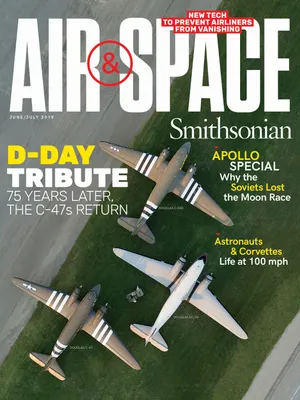Keepers of the Lost Wreck
Amateur crash site investigation is more than a hobby. It’s an ideology.
/https://tf-cmsv2-smithsonianmag-media.s3.amazonaws.com/filer/fa/d6/fad68044-5be8-4562-bc11-57b9ad3f1d73/02g_jj2019_dc-3dakotatailpeekingimg_1575_live.jpg)
Seventy-seven years ago, Lieutenant Constant S. Owen was flying his Lockheed P-38 through the Front Range mountains just outside Denver, Colorado. The single-seat fighter had two engines housed in twin booms, making it one of the heaviest and most distinctive fighters of World War II. This one was an F-4 reconnaissance variant, with cameras in its nose in place of the guns other P-38s were using in dogfights over Germany and Japan.
But Owen would never bring his back home. Because on May 17, 1942, he found himself facing a steep Rocky Mountain slope. Unable to summon enough power from the twin engines to climb above it, Owen and his craft hit the hillside, tail first.
The landowners witnessed the crash, from their house miles away. One of them rode to the site, finding the pilot’s body. The U.S. Army Air Forces men arrived on horseback too, picking their way over terrain so formidable that they left most of the wreckage where it lay.
Those leftovers have today brought Larry Liebrecht and Dave Seniw (pronounced SEE-noo) out to Jefferson County on a cloudy June morning. Liebrecht and Seniw are part of the Colorado Aviation Historical Society’s aviation archaeology program—nicknamed AvAr.
AvAr trains amateur wreck-hunters as field agents who can find, record, and interpret forensic data from wreckage. The leaders organize expeditions during the few months in Colorado when last season’s snow has melted and the next season’s has yet to fall. AvAr is a leading group in this mostly hobbyist field of study, which is becoming more popular and accessible as history goes digital.
/https://tf-cmsv2-smithsonianmag-media.s3.amazonaws.com/filer/90/78/90785643-c344-447a-aec0-b76c88c95b0e/02b_jj2019_openerfromlarryliebrechtimg_8509_live.jpg)
Liebrecht is driving his four-wheel-drive Nissan on a private road that is not really a road anymore. No one has driven it in years—probably since the last time Liebrecht and the AvAr crew came out here, in 2014—and it’s overgrown, the grass hiding large rocks and holes. The only hint of its road-ness comes in the form of axle-wide gaps between trees. We bounce along at about five miles an hour—me frequently giving voice to my fear we’ll slide down some hill; Liebrecht saying this is one of the best parts.
“Aviation archaeology is like rednecking intellectually,” he says, his eyes still on the “road.” “You get to go four-by-fouring and spend the day outside, but you do research.”
Liebrecht soon pulls the Nissan up to an assembly of boulders gathered in front of a trail that also used to be a derelict road. We peer down it.
“I see the obelisk!” Liebrecht says, referring to a giant column of quartz jutting up from the ground like a magic crystal in a fantasy novel. It marks the faint path down to Owen’s wrecked airplane.
We gather our packs—water, food, GPS, rain gear, cameras—and put on work gloves. Liebrecht and Seniw have been to the site before; today’s visit is mostly to show me what AvAr is all about. Still, they regularly find new wreckage at old-news sites—a gauge here, a piece of tubing there, unearthed by erosion or newly visible because of changing undergrowth. They will mark the new pieces, if they’re substantial enough, with the GPS device, take pictures of everything, and send a trip report to their compatriots upon their return.
Liebrecht, a real estate appraiser, and Seniw, a programmer, grab hiking poles and copies of the map Liebrecht made, with little lat-long-marking triangles where agents have found P-38 pieces.
Minutes later, we set off into the nearly impenetrable scrub oak that tries to slap us in the face the whole way down—down to the point, hundreds of feet below this mountaintop, where Owen couldn’t go any higher.
Liebrecht and Seniw are both certified AvAr field agents, trained to visit sites like Owen’s, treat them well, and learn something from the puzzle pieces. Anyone who pays $100 and attends the course they created, in cooperation with an archaeologist from the U.S. Forest Service, can earn the same certification.
But before the Colorado Aviation Historical Society started AvAr, most people who visited airplane-crash sites did it on their own, without any education. Some wreck-chasers even took tokens and contaminated the sites’ forensic evidence. That’s not just bad for study: It’s illegal, at least for crash sites more than 50 years old. “We decided we should be a little bit more methodical,” says the society’s Lance Barber, who, along with Brian Richardson, a Federal Aviation Administration manager, runs AvAr. Richardson works at the FAA by day and helps lead this program in his free time.
They take it seriously. When I first emailed Richardson to ask for an interview and permission to tag along on an expedition, I made the mistake of calling AvAr a “club.”
“AvAr is not a club,” he wrote back. “AvAr is an ideology. There are any number of folks out there claiming to be aviation archaeologists, but few will deliver the same quality of report as expected.”
End of email.
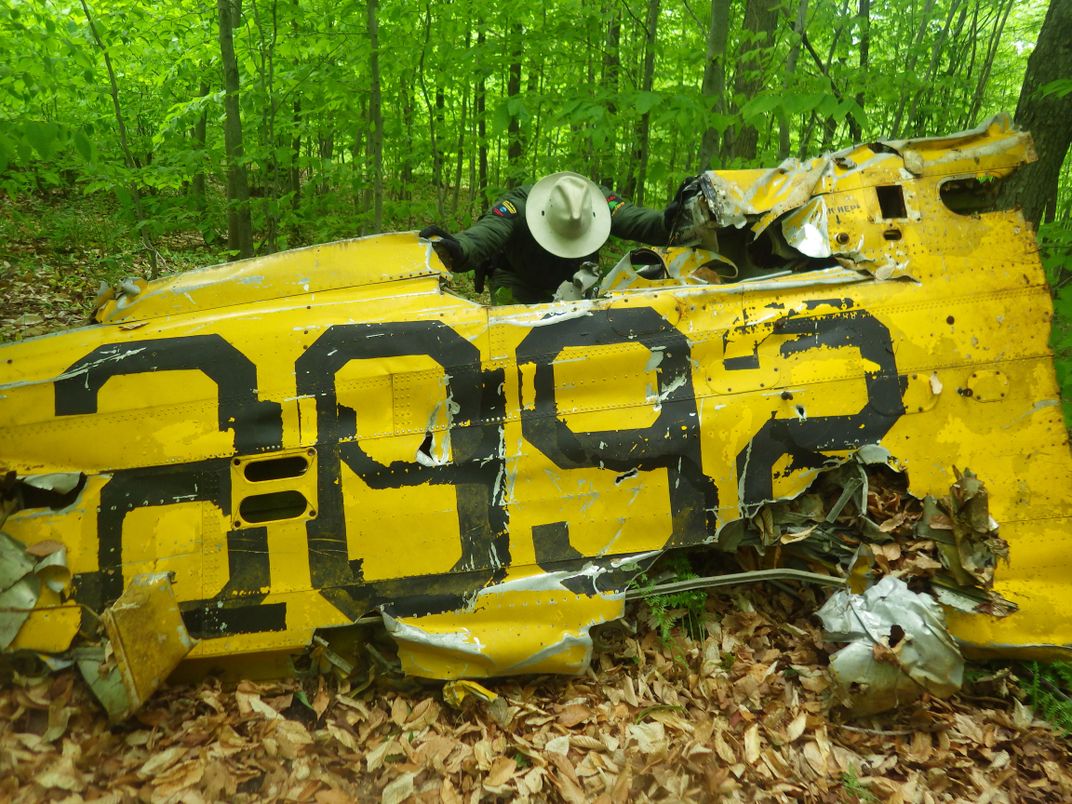
The society has spent a lot of time making sure that claim is true. About a decade ago, they brought in archaeological experts, who taught them how to maintain the purity of a crash site and how to gather useful data they could give to the Forest Service, on whose land many crashes take place. The program has certified 40 field agents, who have taken the archaeologist-created course and pledged not to steal from or deface crash sites. “There are some guys who see it as a way to make money off parts,” says Liebrecht. That’s the main split between those who favor certification and those who resist it: AvAr doesn’t put up with members selling relics on eBay—or anywhere else.
* * *
Today, Liebrecht and Seniw are scrambling down this mountainside to see if they can learn anything new from a site both of them have visited before—Liebrecht six times. After we bushwhack through dense brush for several sweaty minutes, Liebrecht says he believes we’re just above the wreckage. It’s impossible to tell: The scrub oak is so thick that a P-38 wing could be 50 feet in front of us, and we wouldn’t know it. We spread out, performing what CSI would call a parallel search.
“Just look for aluminum,” Liebrecht tells me.
And then, right away, I see some.
“I see some!” I say.
It’s not much—a long, thin cylinder that looks like a windshield wiper blade (it isn’t)—and doesn’t reveal anything much about the airplane, having no numbers or identifiable parts. But it means that we’re in the right spot. Soon, I come across a rivet-studded piece about a foot-square and I am, again, pleased with myself. But then, Seniw shouts from his invisible spot in some other section of scrub oak, “Landing gear!”
It’s much more impressive than my piece: Heavy, rusted, bent with an elbow it shouldn’t have.
A few dozen feet down the hill, Liebrecht finds another set of landing gear. The two take pictures, using their hands for scale, and re-mark the location using a GPS receiver. At other sites, on bigger expeditions in previously unvisited locations, the field agents would create a grid, x-y-ing the spots where they find debris so they can try to discern the airplane’s trajectory from how its pieces came to land.
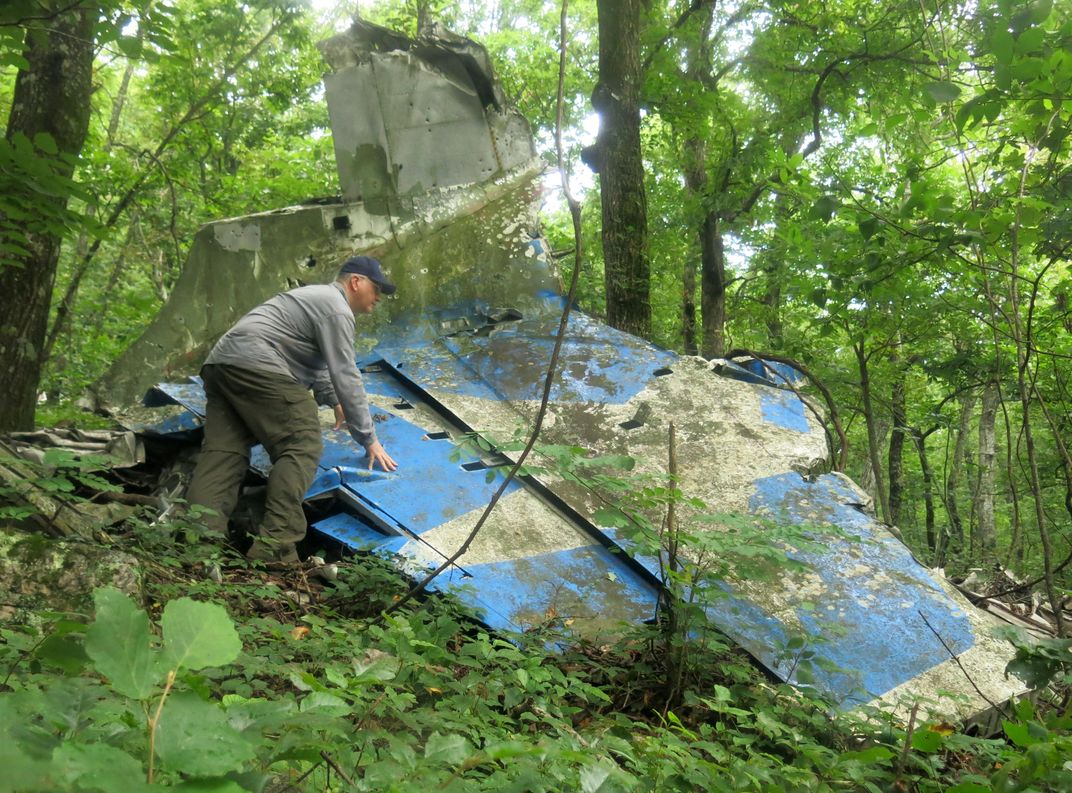
Soon I make a legitimate discovery—a previously un-ID’ed part—with numbers above a hex-shape nozzle. Liebrecht says he doesn’t know what it is. He will look those numbers up later, parse pictures in old P-38 manuals to see if he can tell where this part once fit in the whole.
And then we come upon the propeller—which Liebrecht finds farther down and which he has found before. Not all of the blades remain intact. The remaining ones bite into the ground.
“Think of the force,” Liebrecht says, and trails off.
“Ripped them right off,” says Seniw.
* * *
In Colorado alone, there are 990 crash sites. The thing about crash sites—especially old military ones—is that they’re not easy to know about. Wreck-chasers used to have to comb through old newspapers (or do oral interviews with old-timers) for clues about locations, and then scour the countryside for aluminum.
Today, research is easier (thanks, Internet). An organization called Aviation Archaeological Investigation and Research (AAIR) says it has, over its 14 years of existence, obtained thousands of accident reports from the military and pulled them together into a database. Craig Fuller, head of AAIR, also offers weekend training workshops not unlike AvAr’s (although considerably pricier).
Both Fuller’s group and Colorado’s AvAr want people who go out to crash sites to first enact the National Park Service ethos: Take only pictures (and GPS coordinates); leave only footprints. Hewing to that code, look for serial numbers, part numbers, and inspection stamps. At home, look up those identifiers in old aircraft catalogs or on the online Aero Part Identify Board.
And for many archaeological finds that show no trace of numbers, the seekers can still identify large-scale parts, and how they once contributed to the story at this site: Where is the tail relative to the nose? What does that say about the kinetics of the crash? For the P-38, for instance, the fact that its tail is farthest down the mountain tells Liebrecht that Owen crashed while pulling up, and the swath of uphill wreckage shows that the airplane skidded along the ground for some distance before coming to a rest.
Fuller’s AAIR and the Colorado Aviation Historical Society’s AvAr aren’t the only groups that want to learn from and preserve aircraft debris fields, although they are the most firmly established and professionalized.
AvAr rules the Mountain West. “Currently we, a group of about 15 aviation archaeology and history buffs throughout the West, are in the process of trying to start up an international organization on aviation archaeology over the next few years,” says Liebrecht. But there’s also Arizona Wrecks and Arizona Aviation Archaeology, as well as the Texas Wreckchasing Forum. Then there’s Aviation Archaeology in Maine and Michigan Aviation Archaeology. We’ve got Oklahoma Wreckchasing, the Hawaii Aviation Preservation Society, and wreckchasing.com. The movement is international: The Northern Ireland Aircraft Crash Investigation Team and the Lancashire Aircraft Investigation Team occupy the British Isles. In Canada, the Canadian Harvard Aircraft Association also offers courses and expeditions.
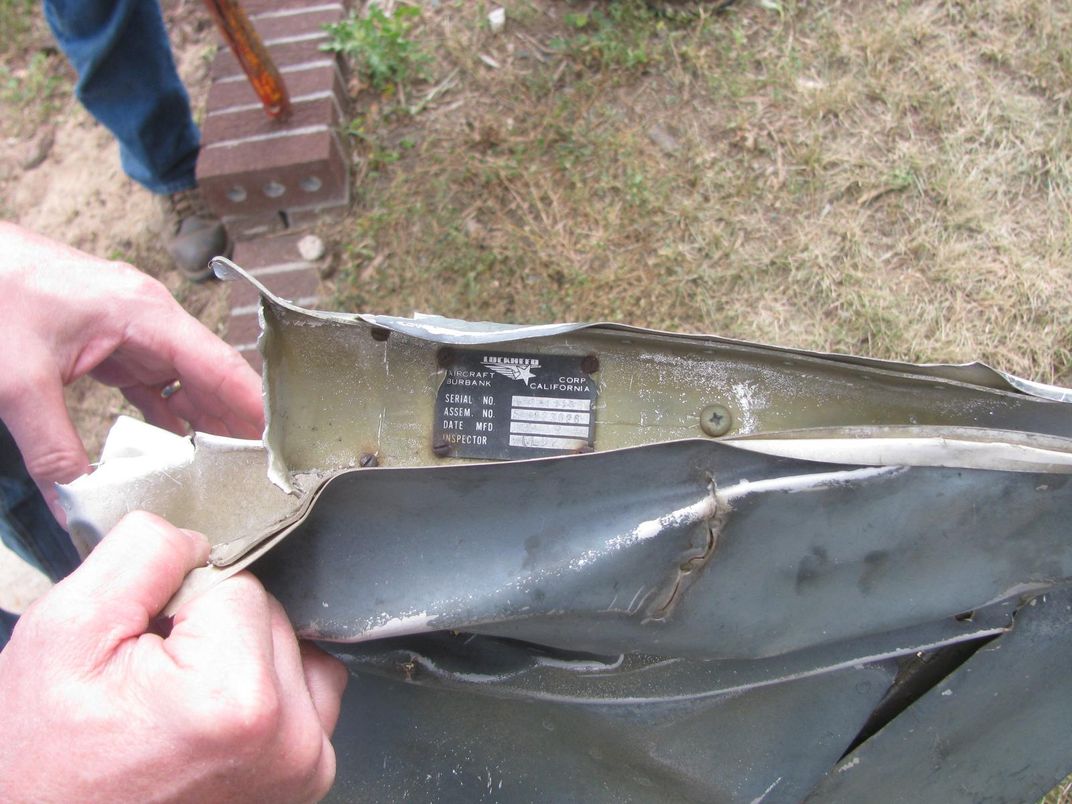
These groups, and the hobby generally, have become more accessible in part because increasing digital information and the availability of reports have led to deeper knowledge of crash locations—although Liebrecht notes that many more people take their certification course than actually continue to go on their expeditions, and that most are older men. Increased ability to image-search for parts, and ctrl-F through catalogs, meanwhile, have meant that amateur archaeologists can better interpret the crashes they do find. But there’s a fundamental tension between the desire to involve more people and gather more information and the desire to preserve the fragments scattered across mountainsides the world over. The philosophy behind AvAr certification is to make sure that as people gain access to information, they know what to do with it.
AAIR has a Historic Aircraft Crash Site Report Form—on which the airplane hunters relay everything from location details to property damage to signs of combustion to serial numbers—and a database of filled-out forms as models. At AvAr, though, the archaeologists keep their own records—storing them at the Wings Over the Rockies Museum in Denver—and don’t publish the locations of most sites they visit. They also don’t advertise their expeditions much beyond the people who are already in the group or those who email them, like me. They’re afraid people will steal parts, go just to gawk, or trespass where they’re not allowed.
That’s why Liebrecht made me promise not to reveal any road names leading to the P-38 crash site, which is still on private property. The landowner wants to keep the airplane there—preserved. Which makes sense archaeologically—also emotionally, in that it is a kind of memorial.
We continue on in what Liebrecht believes is the direction of the tail. After we hike for a few treacherous minutes, gripping trees to keep from sliding down the mountain, the tail rises into view.
It leans against a charred, gnarled tree stump, caught in a notch where the stump has split apart. We stand silent, looking out on the vista, before turning back toward the car. Seniw says that on a previous visit to the site, one of his fellow field agents found the airplane’s rudder pedals.
“Very cool,” I say.
“I guess you could say it’s cool?” Seniw replies. “But it’s also the last thing the pilot’s feet touched.”
* * *
A month or so before I went into the field with Liebrecht and Seniw, I ventured out on my own—to see if I could find a wreck, to see if I could make any sense of it. There’s a crash site near Dillon, Colorado, just off Interstate 70, on Mount Trelease.
The former Martin 4-0-4, a 1950s airliner, was carrying 37 passengers—the Wichita State football team, on their way to play Utah State—and three crew in October 1970. The pilot decided to diverge from the original flight plan and take a scenic route through the Rocky Mountains. The airplane hit the mountainside, and while some survivors managed to climb out, many more remained trapped when the cabin exploded. Twenty-nine people died on the mountain that day, and two more died soon after.
The trek up to the remnants of the crash first required an easy walk up a dirt road. But then came a hard left onto an unofficial trail that goes skyward at a ski-slope angle, gaining 500 feet in a third of a mile. I strapped on my snowshoes and bent forward at the waist.
The mashed-potato snow on top of the four feet of old pack clung in clumps to my crampons, rendering them useless until I stopped—as I did every 10 steps—to knock my feet against tree trunks. I walked down and down, and when I thought I’d gone too far, I took out a map and pretended that might help. Then, looking up in frustration, I noticed a clearing over a mound of earth to my left. Leaving my pack, I clambered over to it. And there—in the middle of the otherwise blank area—were the heaps of aluminum I’d gone there to find. The snow entombed their lower halves and covered the many smaller shards I knew littered the area. But what stuck out from the snow cover was definitely an airplane.
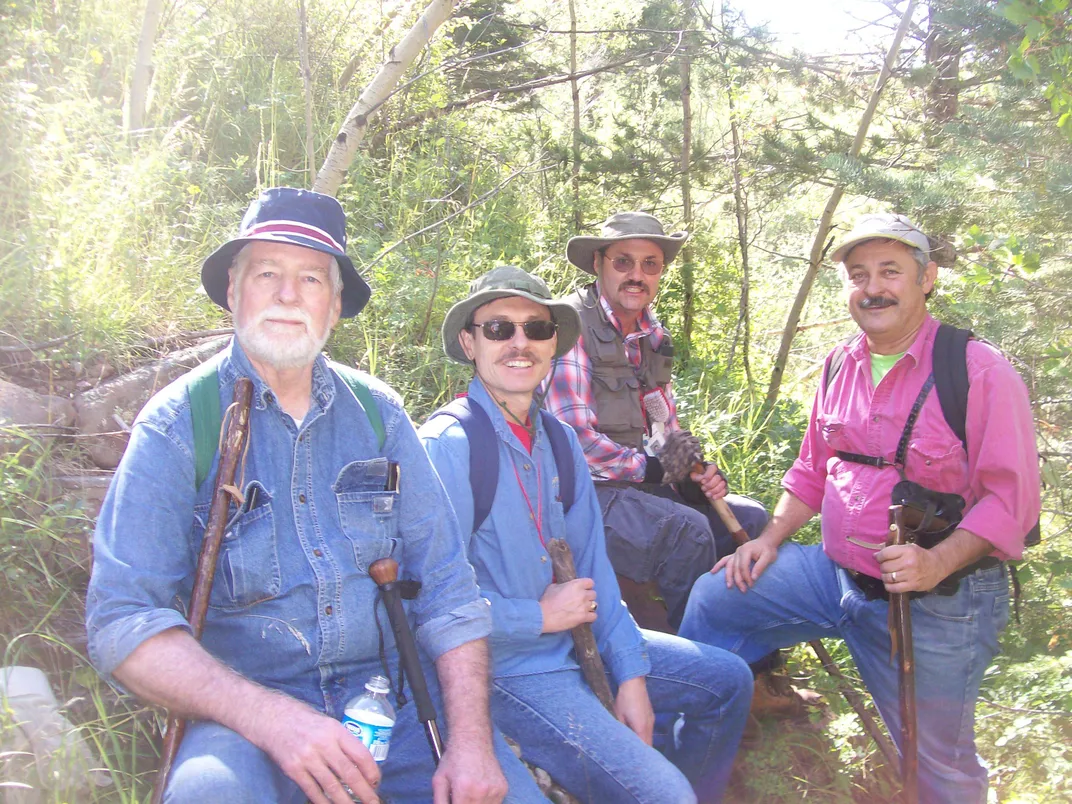
For a second, I felt triumphant: I’d done it. I tried to use the techniques I’d already learned; scanning for part numbers and labels to look up later, trying to identify aero-anatomy, using the layout of the debris to rewind to the airplane’s final moments. But I was no field agent. My insights were insubstantial.
My thoughts turned instead to the passengers. The archaeology of their thoughts, in those last seconds, when sightseeing turned scary, then ended in a transfer of kinetic energy, the mountain pressing back on the airplane with equal force.
Memorials to those lost hung from the airplane parts—little laminated pictures, tangling in the wind. When I looked at the twisted, charred metal, I thought not of handbooks or data logs but of how fragile a thing an airplane is to put between yourself and the world.
